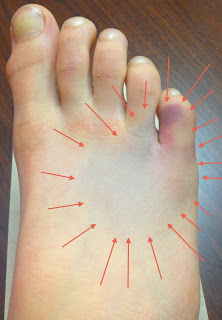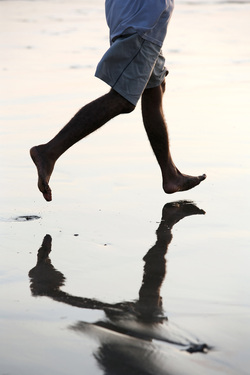
Hi My Running Doc,
A couple of days ago I accidentally kicked the wall with my right foot. My foot still hurts and it is bruised. I read on your website that bruising can be a sign of a metatarsal fracture. How can I tell if it is just bruised or if my foot is actually broken? I would love to have your expert opinion!
Thanks!
David, Houston, Texas.
Hi David,
Bruising is a Bad Sign
It is true that bruising is a bad sign when it comes to foot and ankle injury. When you actually fracture a bone, the bone cracks and bleeds quite a lot. That blood diffuses throughout the soft tissue under the skin. What you see is a bruise. That is part of the reason that a bruise can be so concerning for a fracture in the foot.
In fact the sort of bruising pattern that the picture of your foot shows is often indicative of a fracture or broken bone in the foot. Given your pattern of bruising it is more likely that you have a metatarsal fracture or a fracture in one of the bones in the little toe such as the proximal phalanx phone.
Myths about Foot Fractures
1. If you can walk on the foot, it can’t be broken. FALSE!
This may be one of the most widely perpetuated myths about foot injury on the Internet. I have seen many patients with serious fractures that are walking on the foot. Some patients are limping and obviously in a tremendous amount of pain while other patients with fractures or broken bones barely feel any discomfort at all. This is not a reliable indicator of whether or not you have a broken bone in your foot.
2. There is nothing you can do for a broken toe. FALSE!
This is also absolutely not true. While it is true that most fractures in the toe will heal uneventfully, there are things you can do to speed healing and decrease your risk of complications. Fractures of the bones in the toe can move if not properly stabilized. Certain shoes will speed healing. Taping the toes to provide stability and immobilize the fracture will also help. But some toes should never be taped together.
Without the proper treatment of a broken toe, the fracture can fail to heal leading to what physicians refer to as a nonunion. A fracture that never heals correctly can lead to pain, disability and interfere with your ability to run or even walk without pain. Occasionally patients that take the approach that “nothing can be done for fractured toe” just end up in surgery later. For the most part this is avoidable if the toe treated correctly.
Diagnosis and Treatment Options
If you are suspicious that there might be a broken bone in your foot (or in one of your toes) it is best to figure out whether or not it is actually broken. The best option is to have an in-person evaluation by a sports medicine specialist such as a sports podiatrist. The second option is to have a remote consultation with a sports podiatrist via webcam. A third option is an attempt at self-diagnosis. This video on YouTube can show you how to perform self-diagnosis of metatarsal stress fractures. This same video would apply in your case if the pain is located where you’re bruising is in the foot.
If you see a physician in person or via webcam or you perform your own self-diagnosis and think that you probably have a fracture then you should get x-rays. X-rays will not only confirm (or rule out) a broken bone in the foot but it will also give you an idea of the severity of the problem. There are some fractures that absolutely must be treated surgically. Others simply need a fracture walking boot in order to stabilize the fracture and allow it to heal. And occasionally it is necessary to use crutches.
But not all fractures are the same. So if you have pain and bruising after this sort of injury and suspect that you have a fracture in your foot it is important to determine whether or not there actually is a broken bone, and treat it appropriately. As long as you treat the fracture correctly you should be able to heal and then get back to running.
Dr. Christopher Segler, DPM is Board Certified, American Board of Podiatric Medicine. He believes the best podiatry practice combines cutting edge technology with the old-school convenience of house calls. He makes podiatry house calls for young active adults who want to get rid of their funky toenails as quickly as possibly. He brings the laser to homes and offices throughout the Houston Metro including the Houston Heights, The Woodlands, Baytown and Sugar Land, Texas. If you have a question about fungal toenail laser treatment, you can reach him directly at 713-489-7674.
A couple of days ago I accidentally kicked the wall with my right foot. My foot still hurts and it is bruised. I read on your website that bruising can be a sign of a metatarsal fracture. How can I tell if it is just bruised or if my foot is actually broken? I would love to have your expert opinion!
Thanks!
David, Houston, Texas.
Hi David,
Bruising is a Bad Sign
It is true that bruising is a bad sign when it comes to foot and ankle injury. When you actually fracture a bone, the bone cracks and bleeds quite a lot. That blood diffuses throughout the soft tissue under the skin. What you see is a bruise. That is part of the reason that a bruise can be so concerning for a fracture in the foot.
In fact the sort of bruising pattern that the picture of your foot shows is often indicative of a fracture or broken bone in the foot. Given your pattern of bruising it is more likely that you have a metatarsal fracture or a fracture in one of the bones in the little toe such as the proximal phalanx phone.
Myths about Foot Fractures
1. If you can walk on the foot, it can’t be broken. FALSE!
This may be one of the most widely perpetuated myths about foot injury on the Internet. I have seen many patients with serious fractures that are walking on the foot. Some patients are limping and obviously in a tremendous amount of pain while other patients with fractures or broken bones barely feel any discomfort at all. This is not a reliable indicator of whether or not you have a broken bone in your foot.
2. There is nothing you can do for a broken toe. FALSE!
This is also absolutely not true. While it is true that most fractures in the toe will heal uneventfully, there are things you can do to speed healing and decrease your risk of complications. Fractures of the bones in the toe can move if not properly stabilized. Certain shoes will speed healing. Taping the toes to provide stability and immobilize the fracture will also help. But some toes should never be taped together.
Without the proper treatment of a broken toe, the fracture can fail to heal leading to what physicians refer to as a nonunion. A fracture that never heals correctly can lead to pain, disability and interfere with your ability to run or even walk without pain. Occasionally patients that take the approach that “nothing can be done for fractured toe” just end up in surgery later. For the most part this is avoidable if the toe treated correctly.
Diagnosis and Treatment Options
If you are suspicious that there might be a broken bone in your foot (or in one of your toes) it is best to figure out whether or not it is actually broken. The best option is to have an in-person evaluation by a sports medicine specialist such as a sports podiatrist. The second option is to have a remote consultation with a sports podiatrist via webcam. A third option is an attempt at self-diagnosis. This video on YouTube can show you how to perform self-diagnosis of metatarsal stress fractures. This same video would apply in your case if the pain is located where you’re bruising is in the foot.
If you see a physician in person or via webcam or you perform your own self-diagnosis and think that you probably have a fracture then you should get x-rays. X-rays will not only confirm (or rule out) a broken bone in the foot but it will also give you an idea of the severity of the problem. There are some fractures that absolutely must be treated surgically. Others simply need a fracture walking boot in order to stabilize the fracture and allow it to heal. And occasionally it is necessary to use crutches.
But not all fractures are the same. So if you have pain and bruising after this sort of injury and suspect that you have a fracture in your foot it is important to determine whether or not there actually is a broken bone, and treat it appropriately. As long as you treat the fracture correctly you should be able to heal and then get back to running.
Dr. Christopher Segler, DPM is Board Certified, American Board of Podiatric Medicine. He believes the best podiatry practice combines cutting edge technology with the old-school convenience of house calls. He makes podiatry house calls for young active adults who want to get rid of their funky toenails as quickly as possibly. He brings the laser to homes and offices throughout the Houston Metro including the Houston Heights, The Woodlands, Baytown and Sugar Land, Texas. If you have a question about fungal toenail laser treatment, you can reach him directly at 713-489-7674.

 RSS Feed
RSS Feed